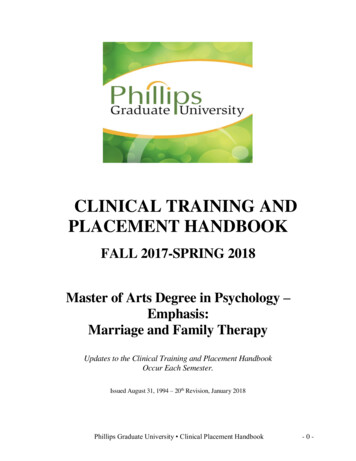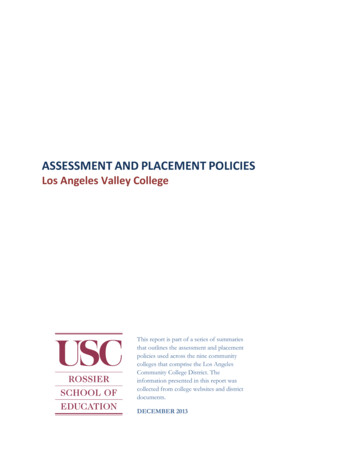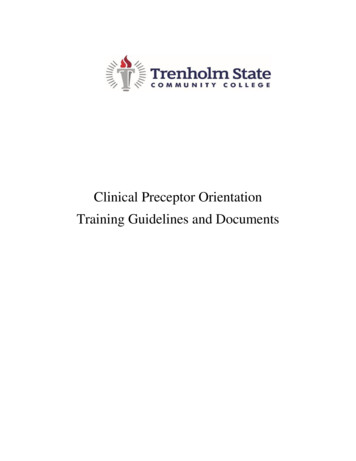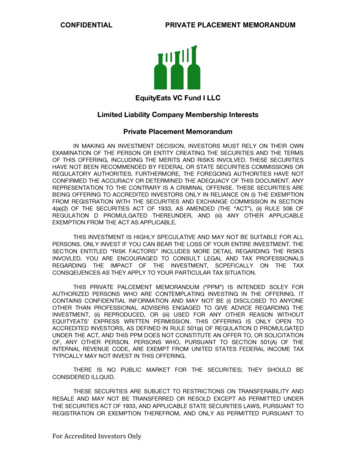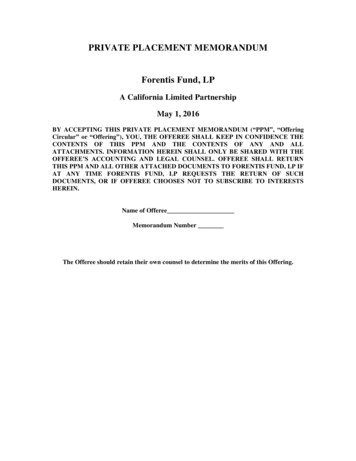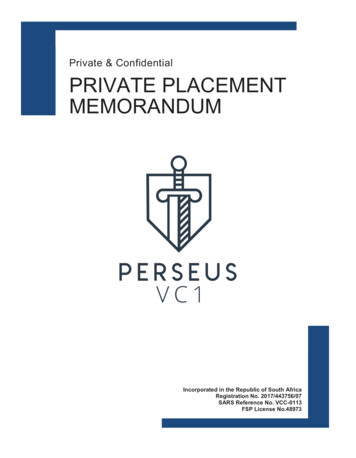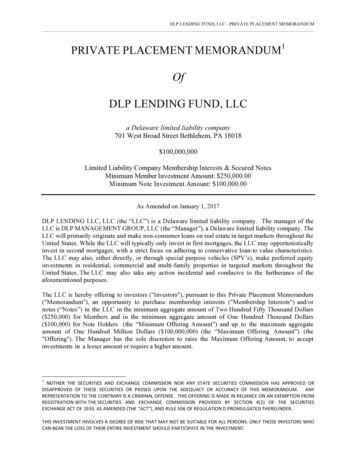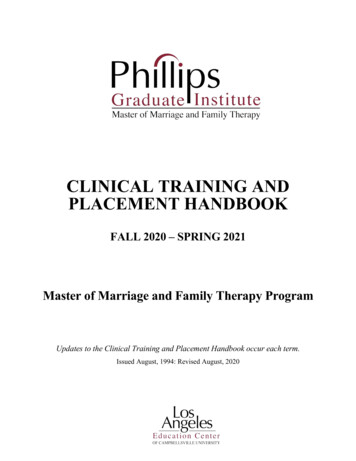
Transcription
CLINICAL TRAINING ANDPLACEMENT HANDBOOKFALL 2020 – SPRING 2021Master of Marriage and Family Therapy ProgramUpdates to the Clinical Training and Placement Handbook occur each term.Issued August, 1994: Revised August, 2020
PHILLIPS GRADUATE INSTITUTELOS ANGELES EDUCATION CENTER OF CAMPBELLSVILLE UNIVERSITYMaster of Marriage and Family TherapyClinical Training and Placement HandbookTable of ContentsI INTRODUCTION1.0 Purpose of this Handbook1.1 Students’ Personal Preparation555II FRAMEWORK FOR PROGRAM AND CLINICAL TRAINING EXPERIENCE2.0 What is the Clinical Training Experience2.1 Systemic/Relational Base for Training2.2 Professional Marriage and Family Therapy Principles2.3 Board of Behavioral Sciences, California State Licensing Board2.4 Students Must Complete All Academic and Clinical Requirement of the Phillips MFT Program2.5 Mission Statement, Program Goals and Student Learning Outcomes2.6 Specific Learning Objectives of the Clinical Training Experience66667778III CLINICAL TRAINING ADMINISTRATION AND STAFF: ROLES AND RESPONSIBILITIES3.0 Co-Director(s), Clinical Training3.1 Clinical Training Coordinator101010IV OVERVIEW OF THE CLINICAL TRAINING SEQUENCE AND REQUIREMENTS4.0 Program of Study and Courses that Provide Clinical Experiences and/or Supervision4.1 Clinical Training Settings4.2 Summary of Clinical Contact Experience Requirements for Graduation and Key Definitions4.3 Summary of Supervision Hours Requirements for Graduation and Key Definitions4.4 Intent to Pursue a License in Another State121213141618V BEFORE WE BEGIN: NURTURING THE THERAPIST-IN-TRAINING5.1 Be Compassionate to Yourself as well as your Clients5.2 Honor the Complexity of the Student’s Life as a Professional-in-Training5.3 Share and Enjoy the Journey with your Peers19191920VI PHASE 1 – BEGINNING THE CLINICAL TRAINING EXPERIENCE: FROM CASECONFERENCE TO APPROVAL FOR TRAINEESHIP/PRACTICUM6.0 MFC 519A Case Conference6.0.1 Beginning Documentation of Clinical Hours of Experience6.0.2 Membership in AAMFT and/or CAMFT and Professional Liability Insurance6.0.3 Evaluation and Approval for Traineeship/Practicum6.1 Forms and/or Actions Required212121212122VII PHASE 2 – CLINICAL EXPERIENCE: PREPARATIONS AND REQUIREMENTS FORTRAINEESHIP/PRACTICUM7.0 Courses that Contribute to the Practicum/Traineeship Experience7.1 Educational and Procedural Requirements to Begin Traineeship/Practicum242425Phillips Graduate Institute Los Angeles Education Center of Campbellsville University Clinical Training and Placement Handbook-1-
267.2 Program’s Coordination and Accountability for Students in Clinical Settings7.3 Traineeship/Practicum in an MFT Traineeship Site: Activities, Expectations, Protocols,Requirements of Site7.4 Selection and Approval of an MFT Traineeship7.4.1 California Family Counseling Center (CalFam)7.4.1.a Annual Placement Fair7.4.2 Traineeship Lists7.4.3 Approval of MFT Traineeship Sites7.4.4 MFT Traineeship Selection7.5 Specific Traineeship Requirements of the Board of Behavior Sciences7.5.1 BBS Supervisor Responsibility Statement7.5.2 Volunteer Experience7.5.3 Paid Experience for Students7.5.4 Summary of Restrictions of Trainee/Experience7.6 Forms and/or Actions Required26272727272728293030303031VIII PHASE 3 – CLINICAL EXPERIENCE: IN TRAINEESHIP/PRACTICUM8.0 Clinical Responsibilities and Activities in MFT Traineeship8.1 Case File Documentation and Case Management8.1.1 Paperwork8.1.2 Case Management Tasks8.1.3 Crises8.2 Documentation of Clinical Hours of Experience8.2.1 Weekly Logs8.3 Professionalism8.3.1 Attire8.3.2 Frustrating Interactions8.4 Evaluation of Trainee8.4.1 MFT Trainee Evaluation Form8.4.2 Separate Evaluation by the ATM Instructor/Supervisor8.5 Notification of Traineeship Changes8.6 Request to Terminate a Traineeship8.7 Student/School Vacations and Trainee Responsibility to the Traineeship8.8 Forms and/or Actions Required323232323232323232323333333333333434IX PHASE 4 – CLINICAL EXPERIENCE: COMPLETION AND TERMINATION9.0 The Final Term and Completion of the 450 Hours9.0.1 Closure Plan9.0.2 Mid-Term Termination9.1 Incomplete Hours9.1.1 Plan9.1.2 Practicum9.1.3 Liability Insurance Renewal9.2 Closure Requirements9.2.1 Completion and Approval of Clinical Documentation9.2.2 Final MFT Trainee Evaluation9.2.3 Student Evaluation of Traineeship Experience9.3 Forms and/or Actions Required35353535353535353535363636Phillips Graduate Institute Los Angeles Education Center of Campbellsville University Clinical Training and Placement Handbook-2-
X SUPERVISION10.0 Summary of the Supervision Hours Requirement for Graduation10.0.1 Summary of Table10.1 Definition and Functions of Supervision10.1.1 Monitor Client Welfare10.1.2 Evaluate Progress10.1.3 Enhance Professional Development and Competence10.2 Qualifications and Requirements for Supervisors10.2.1 Qualifications and Requirements for Phillips Faculty Supervisors10.2.2 Qualifications and Requirements for MFT Traineeship Site Supervisors10.3 Students’ Responsibilities for Supervision10.4 Management of Recorded Sessions10.5 Supervision between Terms or when Phillips is not in Session10.6 Managing Difficulties and Plans for Remediation10.7 Forms and/or Actions Required373738383838393939404041414142XI GUIDELINES FOR DOCUMENTING CLINCIAL HOURS11.0 Phillips and BBS Documentation Systems11.1 Guidelines for Completing the Phillips Clinical Hours of Experience Log11.1.1 Weekly Documentation11.1.2 Supervisor Signature11.1.3 Therapy or Client Contact Hour11.1.4 Individual or Relational/Family Hours11.1.5 Alternative Hour11.1.6 Co-Therapy11.1.7 Group Therapy11.1.8 Individual or Group Supervision11.1.9 Case Report, Video or Live Supervision11.1.10 Simultaneous Therapy and Live Supervision11.1.11 Video Presentation in Group Supervision11.1.12 Exclusions from Counting11.2 Sample Phillips Clinical Hour of Experience Log11.3 Guidelines for Completing the BBS Weekly Summary of Hours of Experience Form11.3.1 Weekly Summary of Experience Form Documentation11.3.2 Supervisor Signature11.3.3 Direct Counseling with Individuals, Groups, Couples or Families – Category A11.3.3.a Individuals11.3.3.b Couples, Families and Children11.3.3.c Group Therapy or Counseling11.3.3.d Telehealth11.3.4 Non-Clinical Experience – Category B11.3.4.a Written Clinical Reports11.3.4.b Workshops, Seminars, Training Sessions, Conferences11.3.4.c Client Centered Advocacy11.3.5 Non-Clinical Experience Supervision – Category B1 and B211.3.5.a Individual Supervision11.3.5.b Group 54545464646464646464646Phillips Graduate Institute Los Angeles Education Center of Campbellsville University Clinical Training and Placement Handbook-3-
474711.4 Sample BBS Weekly Summary Hours of Experience Form11.5 Forms and/or Actions RequiredXII PERSONAL PSYCHOTHERAPY12.0 Purpose of a Personal Psychotherapy Experience12.1 BBS State Policy regarding Personal Psychotherapy for MFT Trainees and Associates12.2 Phillips School Policy12.3 Forms and/or Actions Required4848484848XIII PROFESSIONAL ORGANIZATIONS13.0 American Association for Marriage and Family Therapy13.1 California Association for Marriage and Family Therapists494949XIV PROFESSIONAL ETHICS14.0 Ethical Standards for Marriage and Family Therapists14.1 Professional Therapy Never Includes Sex505050XV BBS-MFT ASSOCIATE REGISTRATION15.0 Introduction15.1 Requirements for Associate Registration15.2 Procedures for MFT Associate Registration51515151XVI FORMSForm I - Statement of Intent to Pursue a Post-Degree TitleForm II - Documentation of Personal PsychotherapyForm III - Notification of Clinical PlacementForm IV - MFT Trainee Evaluation FormForm V - Notification of Traineeship ChangesForm VI - Request to Terminate TraineeshipForm VII - Student Evaluation of TraineeshipForm VIII - Phillips Clinical Experience Hour LogForm IX - BBS Supervisor Responsibility Statement (link)Form X - BBS Weekly Summary of Hours of Experience (link)Form XI - BBS Experience Verification Form (link)535456575864656668696969XVII APPENDICESAppendix A Student Checklist for Beginning and Completing the Clinical ExperienceAppendix B Summary of Hours of Experience form the BBS for MFT LicensureAppendix C AAMFT Core CompetenciesAppendix D AAMFT Code of Ethics7070717171Phillips Graduate Institute Los Angeles Education Center of Campbellsville University Clinical Training and Placement Handbook-4-
PHILLIPS GRADUATE INSTITUTELOS ANGELES EDUCATION CENTER OF CAMPBELLSVILLE UNIVERSITYMaster of Marriage and Family TherapyClinical Training and Placement HandbookIINTRODUCTION1.0Purpose of this Handbook.This Clinical Training and Placement Handbook pertains to the Master of Marriage and FamilyTherapy degree program at Phillips Graduate Institute, Los Angeles Education Center ofCampbellsville University (Phillips). The purpose of the Handbook is to guide students throughthe clinical training experience requirements and procedures of the program in order to supportstudents’ achievement of the Program’s Goals and Student Learning Outcomes and insurepreparation and eligibility for licensure as a Marriage and Family Therapist (LMFT) inCalifornia. This Handbook is also located on the Phillips website, phillips.campbellsville.edu.Students are responsible for knowing the requirements and procedures outlined in thisHandbook. Class instruction is provided every term to assist students through the clinicalexperience component of the program. All students are required to attend all class meetings, takean in-class quiz, and read this Handbook to ensure they have this essential information.Students are held to the requirements published in the Handbook and other institutionalpublications for the year admitted to the program. If any change(s) to clinical/practicumrequirements or policies occur once a student is admitted, then students will be given adequatenotice of the change(s). Any change(s) in procedures that may be implemented for improvementsin communication or recordkeeping shall also be communicated to students. Every effort will bemade to minimize disruption.1.1Students’ Personal Preparation.Students generally consider the clinical experience to be the heart of their preparation and oftenanticipate it with both excitement and a little anxiousness. This is understandable! Once involvedin clinical work, students most often find that it is very rewarding, brings great learning andexpanded perspectives, and achieves long desired dreams. It is also a very demanding phase ofthe program, both in terms of the time demands on the students’ commitment to the program andimpacts on other aspects of life, both pragmatically and emotionally. Students must anticipateadjusting and reducing other life commitments including work schedules to complete theprogram within the advertised time for completion. While faculty and supervisors work toprovide a supportive learning environment with respect for the many demands of students’ livesand work with students to generate a clinical experience that meets students’ experience and lifeneeds, the requirements may not be altered.Phillips Graduate Institute Los Angeles Education Center of Campbellsville University Clinical Training and Placement Handbook-5-
IIFRAMEWORK FOR PROGRAM AND CLINICAL TRAINING EXPERIENCE2.0What is the Clinical Training Experience?Clinical training is the MFT program component in which students provide individual, couple,family, and group therapies in approved settings under approved supervision. Students providetherapy with a broad range of client populations that include diversity in identities andbackgrounds as well as in presenting problems and diagnoses. Services may be provided in awide variety of settings, such as a residential facility, a multi-service community mental healthcenter, schools, or home-based program. Students participate in a variety of activities at thetraining site that may include therapy, assessment, intake, treatment planning, case management,clinical supervision, trainings, and clinical documentation. While students’ participation in theseactivities and others is essential to a well-rounded learning experience, all activities are notcounted towards graduation and licensure equally (see Section XI: Guidelines forDocumenting Clinical Hours). Students may work alone or as co-therapist in providing therapyservices.2.1Systemic/Relational Base for Training.Theories and practice models with their roots in a systemic/relational perspective underpin mostcourses in the program (e.g. Bowenian, Solution-Focused, Structural, Narrative therapies).Systemic/relational theory and practices are applied in the clinical experience component andadvanced through systemic/relational supervision. Students are also introduced to a variety ofindividual-based models and approaches throughout the program and in clinical trainingplacements. These approaches enhance learning and provide the opportunity to view humanbehavior through different lenses and integrate different ideas.2.2Professional Marriage and Family Therapy Principles.The Professional Marriage and Family Therapy Principles (PMFTPs) are a set of principlesidentified by the American Association for Marriage and Family Therapy (AAMFT) as core tothe national identity of and preparation for the MFT field. This set of principles shapes thelicensure laws in all states and underpins the national licensure exam in MFT. The PMFTPsinclude: state licensure laws and regulations (for California, the Board of Behavioral Sciences(BBS)); the AAMFT Core Competencies, a set of 128 specific competencies expected for theentry level MFT (Appendix D); the Association of Marriage and Family Therapy RegulatoryBoard (AMFTRB) Domains of Knowledge assessed through the national MFT exam; and theAAMFT Code of Ethics (Appendix E), the national standards for professional and ethicalbehavior.While all sets of PMFTPs are embedded in the Phillips program and clinical training, theexpectations for clinical training that emerge from the national MFT identity and principles ofthe AMFTRB, Core Competencies, and AAMFT Code of Ethics and the expectations for clinicaltraining that emerge from the California MFT identity and BBS laws and regulations forlicensure lead to some important differences in clinical training requirements. The MFT programand clinical training requirements align with the national PMFTPs and maximize theopportunities for students and graduates to achieve licensure and employment both inside andoutside of California. These requirements pertain to completion requirements for the PhillipsMFT Master program.Phillips Graduate Institute Los Angeles Education Center of Campbellsville University Clinical Training and Placement Handbook-6-
2.3Board of Behavioral Sciences, California State Licensing Board.The California Board of Behavioral Sciences (BBS) is the state Consumer Protection agency thatregulates the practice of Marriage and Family Therapy through legislation that defines theeducational and practice requirements and procedures for attaining MFT licensure and enforcinglegal practice of MFT professionals. The BBS prescribes requirements both for the Masterdegree and for additional post-degree clinical experience to be eligible to take the state licensingexam in MFT. The academic and clinical experience requirements of the program are designedto insure students’ eligibility for licensure. To become licensed as an MFT, graduates mustcomplete and pass all program requirements, complete additional clinical hours undersupervision and, sometimes, additional coursework post-graduation (for applicants with out-ofstate degrees), and successfully pass two written exams administered by the BBS.2.4Students must complete all academic and clinical requirements of the Phillips MFTProgram. Because of the differences between the national and state clinical trainingrequirements, students are required to maintain two sets of documentation ofclinical hours of experience to demonstrate achievement of each (see Section XI:Guidelines for Documenting Clinical Hours). The BBS and AAMFT PMFTPssometimes use different terminology and different definitions to describe clinicalexperience components. This Handbook will identify and clarify these differences.2.5Mission Statement, Program Goals and Student Learning Outcomes.Phillips Graduate Institute Los Angeles Education Center of Campbellsville University,Marriage and Family Program Mission StatementThe mission of the Master of Marriage and Family Therapy program at Phillips is to create aneducational experience that fosters collaborative learning and provides students with theacademic knowledge, clinical competency, and professional development necessary forbeginning practice as marriage and family therapists within a multicultural environment.Students who complete the program are responsive to the many aspects of diversity that existwithin human relationships. They demonstrate self-awareness, a commitment to ethical practice,and relational responsibility in service to individuals, couples and families, to their communities,and to the profession of marriage and family therapy. Students who complete this program willhave met the educational requirements for the LMFT licensure in California.While Program Goals and Student Learning Outcomes are addressed with varying focusthroughout the coursework, clinical experience is where they are integrated and continuallypracticed.MFT Program Goal #1: Knowledge of a variety of developmental theories, relational/systemictheoretical models, as well as other models of human behavior.1.1Students are able to identify, demonstrate an understanding of, and apply a variety ofmodels of human development throughout the lifespan.1.2Students are able to identify, demonstrate an understanding of, and apply a variety ofsystemic/relational as well as other theoretical models in marriage & family therapy.Phillips Graduate Institute Los Angeles Education Center of Campbellsville University Clinical Training and Placement Handbook-7-
MFT Program Goal #2: Knowledge and skills in the assessment, diagnosis, and researchinformed treatment of individuals and relational systems.2.1Students apply appropriate skills in the assessment, diagnosis, and treatment ofindividuals, couples, and families in the development of comprehensive treatment plans.2.2Students apply knowledge of human behavior in health and mental illness to the practiceof marriage and family therapy.2.3Students locate, critically evaluate, and apply published research in the development ofcomprehensive treatment plans.MFT Program Goal #3: Practice of relational/systemic therapy in a manner that is consistentlyresponsive to the impact of culture and diversity on all relationships.3.1Students demonstrate an awareness and knowledge of current and historicalsociocultural factors that influence human interactions, and which impact both client andtherapist within the therapeutic relationship.3.2Students effectively apply culturally responsive perspectives in the practice of marriageand family therapy.MFT Program Goal #4: Practice of relational/systemic therapy in a manner that is grounded inrelevant legal principles and based on ethically sound decision-making.4.1Students identify legal and ethical principles underlying the practice of marriage &family therapy.4.2Students use an ethical decision-making process in their professional practice asmarriage & family therapists.MFT Program Goal #5: Practice of relational/systemic therapy in a manner that demonstratesrelational responsibility and professional behavior.5.1Students demonstrate professional behavior and relational responsibility in allinteractions with peers, faculty, staff, clients, site supervisors, and other professionals.5.2Students demonstrate respect, warmth, and attending behavior in collaboration withclients in a treatment setting.MFT Program Goal #6: Completion of the MFT program with the self-awareness, personalgrow
6.0.2 Membership in AAMFT and/or CAMFT and Professional Liability Insurance 21 6.0.3 Evaluation and Approval for Traineeship/Practicum 21 6.1 Forms and/or Actions Required 22 VII PHASE 2 – CLINICAL EXPERIENCE: PREPARATIONS AND REQUIREMENTS FOR TRAINEESHIP/PRACTICUM 24 7.0 Courses that Contribute to the Practicum/Traineeship Experience 24 .
